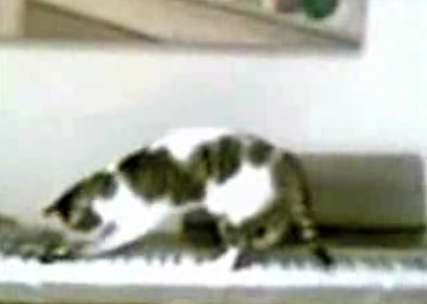
|
Lorna Mills and Sally McKay
Digital Media Tree this blog's archive OVVLvverk Lorna Mills: Artworks / Persona Volare / contact Sally McKay: GIFS / cv and contact |
View current page
...more recent posts
 Still from Cory Arcangel's video Schoenberg’s Cats Last year we criticized Cory Arcangel and Hanne Mugaas’ Art Since 1950 performance pretty heavily on this blog. And there's been some convincing criticism of his video Schoenberg’s Cats at ArtFagCity. So when I went down to Power Plant to see the group show Adaptation I was fully prepared not to like the piece. But it turned out I liked it a lot, for several reasons. First of all, youtube looks fantastic in a gallery. The video was displayed on a not-too-fancy monitor (no high-def plasma screen, just a biggish, oldish monitor on a video cart...very simple) but still much larger than the youtube window online. The pixelated low rez look of youtube, thus translated, is really dramatic. In the context of a high-end gallery where all the other video works had high-end production values, the explosion of blurry pixels and inconsistent quality reads like an intentional aesthetic decision. And it's a good one, very pretty and engaging if you happen to have a taste for the various ways that video can look on screens. There is a lot of ongoing discussion about the failure of curators to deploy social media in the gallery or museum. And I agree that the two contexts don't mash well at all. This was my problem with Art Since 1950... there is nothing more irritating than watching someone else click links. If Arcangel's cat video was not a discrete, edited piece but a curated collection of found cat & piano footage from youtube it would be a real drag. Youtube as-a-resource is better online. The joy of youtube is that there is very little imposed structure and its a participatory community where viewers are creators...etc, etc. Those kinds of modes of engagement just don't translate into a gallery. Sure you could set up a monitor connected to the internet and people could sit and surf through collections online, but why would you? It's much, much more sensible to look at art that way at home. But the Schoenberg cat video, as displayed in the exhibition, is not an example of online art. It's an example of gallery art in the age of youtube, and the aesthetic is instantly recognizeable. Power Plant in summer gets a lot of tourist traffic. It's down by the lake at Harbourfront where people go to eat ice cream, watch buskers, listen to music, take boat tours and buy souvenirs. Many of them wander into the gallery because its free and well marked - big signs and arrows outside the building that say ART, FREE, ENTRANCE, and such like. When I first walked into the space there were two little girls running up to Arcangel's video with their arms outstretched, chirping "Kitties! Kitties!" and then tickling and scrunching their fingers at the screen while various cats flopped around on various pianos. These kids weren't thinking, "My what terrible video quality" they were responding to a medium they recognized with a sense that it belonged to them and they were welcome to interact. I'm a fan of cat and piano videos. I often plop in those search terms to see if there's anything new I've missed. Arcangel's edit is very sweet, and the musical structure is perfect for an installation. It's atonal enough to be believable, cats padding on keyboards creating those very chords, and yet it's melodic enough to give a shape to the piece. The Schoenberg number imposes a narrative structure: beginning, middle and end. And that's necessary when the audience is not online, and free to click away. But at the same time the youtube aesthetic is clear, and curated in together with full-on wall-sized projected video and wall-mounted plasma screens it reads like the people's medium. There are some purists who think that when artists who work online show pieces in a gallery they are selling out the participatory ethics of online interaction. But at the same time, there is grumbling that curators and gallery audiences need to figure out how to address the internet. There are plenty of artists who work in both contexts, and showing sensitivity to the differing audience needs between online and gallery interaction is a genuine skill. I don't like Schoenberg’s Cats online. I'd rather just watch youtube cats that I select myself. But in the Power Plant's white cube, a surprisingly social space on a sunny August afternoon, I enjoyed it very much indeed. |